mission analysis aspects for earth observations missions
mission analysis aspects for earth observations missions
mission analysis aspects for earth observations missions
- No tags were found...
You also want an ePaper? Increase the reach of your titles
YUMPU automatically turns print PDFs into web optimized ePapers that Google loves.
Sentinel -2 System descriptionSatellite• Satellite mass: 1200KG• Satellite power consumption: 1400W (1700W at SolarArray level, GaAs triple junction), 87Ah battery• Hydrazine propulsion system (117Kg)• TT&C using S band (64Kb/s up – 2018Kb/s down), withauthenticated/encrypted commands• X band <strong>mission</strong> data distribution (520 Mbits/sec)• Mission data onboard storage: > 2.4 Tbits• Optical Communication Payload• Wheels, magnetometers, magnetorquers, startrackers, coarse sun and <strong>earth</strong> sensors, accurateInertial Measurement Unit and GPSMultiSpectral instrument• Filter based push broom imager (280KG, 1m 3 )• Three mirrors silicon carbide telescope, with dichroicbeam splitter• Focal plane arrays: Si CMOS VNIR detectors, HgCdTeSWIR detectors passively cooled (190K)• Onboard wavelet compression (~1/3)• Integrated video & compression electronics (state ofthe art wavelet compression)• Radiometric resolution 12bits• Radiometric accuracy < 5%Sentinel -2 Data Delivery– Data delivered to 4 core GS within 1-3 hours after acquisition.– X band data downlink with instrument data rate of 490 Mbit/s (after onboard waveletcompression)– Laser Communication through geo terminal (can be operated simultaneously withthe X band subsystem).– 900 Gbyte per day (1000 CDs): cloud-free images will be further processed.Core GroundStations used<strong>for</strong> thesimulation:Kiruna,Svalbard,Maspalomas,Prince Albert





